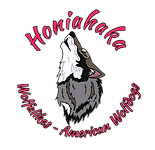

HONIAHAKA NORTHERN INUIT DOGS
Home of the Northern Inuit Dog and Wolfalike Dogs in the UK
Coats & Colours
Northern Inuit and Wolfalike dogs were originally bred to resemble the wolf whilst maintaining the dog like temperament.
Although there have been many years of selective breeding to get the wolfy look desired from these breeds there is still a wide range of diversity in coat colour's, coat length, masks, and eye colour's within the breed and this is translated across most of the other wolfie breeds meaning there is no clearly defined 'type'.
Coat Colours
Wolfie-type dogs come in various coat colours ranging from pure white through to grey, silver, red, timber, black, black and white and occasionally ink marked, which is classed as a fault in the Northern Inuit dog.
Below are examples of the most common coat colours in the Northern Inuit and wolfalike breed
Silver Grey
(White undercoat)

Wolf Grey
(Cream Undercoat)

M' Absolutely Fabulous
Timber
This colour falls into the 3 categories below. (Agouti)
Light Timber
(cream undercoat with darker markings)

Timber
(cream undercoat with dark red & brown markings)

Dark Timber
(beige undercoat dark brown or black coat)

Apricot/Dilute red

Charcoal

Black & White

White

Ink Marked
(Spotted)

All wolfalike types should have a dense, waterproof double-coat, which usually goes through a full moult twice a year. However, the length of the coat can vary from standard double-coat, to plush, through to long-haired which is classed as a fault in the Northern Inuit dog, but some other wolfalike breeds prefer a bit of length to the coat.
Coat Lengths
Standard coat

Plush coated puppy to adult

Here you can see 2 long coated dogs

One of the defining characteristics of the Northern Inuit and many wolfalike breeds is their facial markings which is called a 'mask'. These can vary from no mask (only accepted on pure white dogs), full masks, faded masks and half masks. Below are photos to illustrate the differences between full, half and faded masks.
Masks
Full Mask
Note that the coloured markings completely surround the eye and there is a clear 'stripe' marking extending down the full length of the muzzle with no break. Full masked dogs often have white eyebrow spots.


Faded full mask
Note that these dogs usually have faded colour markings beneath the eyes and a faint stripe which may not reach all the way down the muzzle or may be broken.

Half Mask
Note these dogs do not have the marking surrounding the eye and the majority of the face is white. They may still have a faint or broken stripe down part of their muzzle.

Eyes
Typical eye colour's in the Northern Inuit range from yellow through amber, brown, blue and very occasionally bi-eyed.
Amber eyes

Brown eyes

Yellow Eyes

Blue eyes

Bi Eyes

Bi-eyed, where one eye is a different colour to the other. It can be as obvious as Shanti with one brown and one blue, or as subtle as Tesla where she has 2 different shades of brown eyes, where the lighter one got a tiny blue speck.
If you are thinking about adding a wolfalike breed to your family and are interested in a specific coat colour or eye colour - or combination of both - it is worth checking with your chosen breeder to see what they expect from future litters. An experienced breeder should know what colours they expect from their future litters and which mating may produce the coat or eye colours you are looking for. However, it is also worth mentioning that there is such genetic diversity within the breed that a breeder's guesstimates may not always be 100% correct. Also, note that eye colours can change from puppy through to adulthood.
© of Honiahaka. Please do not use without permission